How fast will A18 in iPhone 16 be? The iPad Pro's M4 can tell us.
Apple is months away from launching the A18 chip in the iPhone 16 Pro. Apple's M4 can tell us a lot about what to expect from that chip, and maybe, a M3 Ultra.
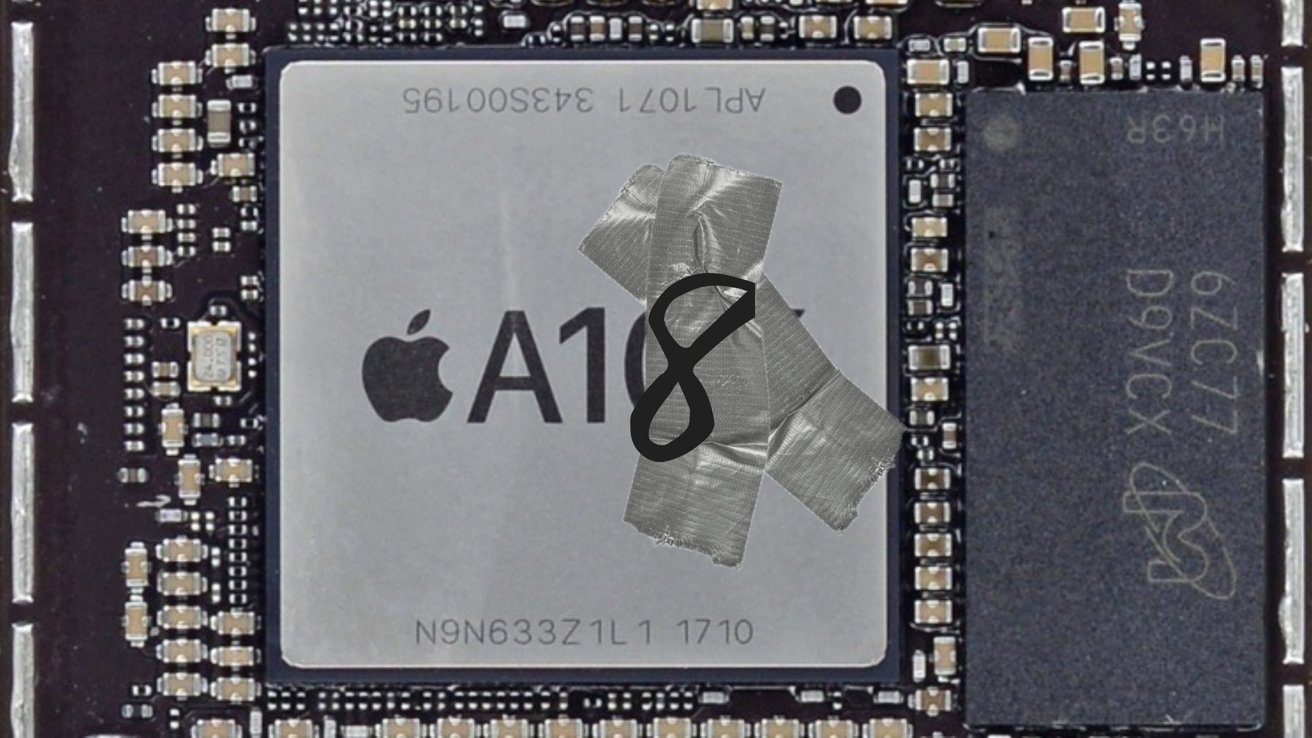
Apple chips are numbered sequentially. The next iPhone chip will likely be the A18.
Apple's shift over to using its own chips has paid off for the tech company. The iPhone is leading the way with its processing capabilities after running on the A-series for quite a few years.
On the Mac side, Apple Silicon is now in its fourth generation, and it too has rocked the PC industry in its own way. Indeed, it kinda rocked itself too, with M4 being announced before an expected M3 Ultra chip made it out of the supply chain.
Apple's mobile chip series is making annual improvements and the Mac chips are close behind. As the attention turns to what Apple has planned for the next batch of Apple Silicon and mobile chips.
A careful examination of previous chip releases and the new M4 in the iPad Pro should give us some hints of what's to come out of Cupertino.
M-Series Apple Silicon - What we know
Of the two chip series we're looking at here, the M-series is the more difficult to understand. This is because Apple releases more chips per generation in the M-Series versus the A-Series.
Excluding smaller variations in core counts for each chip, Apple has released a total of 12 M-series chips across four generations.
Slightly complicating things is Apple's Mac update schedule, which impacts the introduction of its M chips.
That is, the M1 and M2 generations are available in standard, Pro, Max, and Ultra variants. The M3 is in standard, Pro, and Max with Ultra to come, while M4 is out with just the standard release.
Over time, Apple has made improvements that show a considerable level of progression for each tier of chip within a generation. This is pretty much to be expected.
Thanks to its usual level of improvements between chip generations, this makes it reasonably easy to speculate on new chips. That includes the so-far unreleased M3 Ultra and the new round of M4 chips.
For a start, the base chip in the M-series generation tends to be an eight-core chip. This is split between 4 performance cores and 4 efficiency cores.
This trend does change for the M4, with Apple using either nine or ten core chips. In both cases, there are six efficiency cores, but either three or four performance cores.

The iPad Pro is the first to get the M4, but Macs should start getting it soon.
The Pro and Max chips tend to have a few more cores available, with the M3 going up to a maximum of 16 cores. In that chip, it's split into 12 performance cores and four efficiency cores.
The Ultra chips are practically two Max chips attached to each other. Any data points for the Max chip of a generation are doubled in that chip.
GPU core counts also have slowly grown over time, from 7 or 8 in the M1 to 10 in the M4.
The Neural Engine has kept at 16 cores throughout Apple Silicon's life, 32 for the Ultra chips. However, by increasing what each core can do, thanks to higher transistor counts, there has been a gradual improvement between generations.
For M1, that's 11 trillion operations per second for the Neural Engine, rising to 15.8 for the M2 generation, and 18 in the M3.
Things dramatically changed in the M4, with Apple claiming it is capable of 38 trillion operations per second. That is more than double the Neural Engine capability of the M3.
One other thing that improves performance is the memory bandwidth. The M1 had just 68.25GB/s of memory bandwidth, rising to 200GB/s for M1 Pro, 400GB/s for M1 Max, and 800GB/s for M1 Ultra.
Memory bandwidth has jumped around a fair bit over time, such as the M3 Pro's 150GB/s bandwidth, but the core chip's gradually risen to 120GB/s in the M4.
M-Series Apple Silicon - Performance gains
Since there are so many changing elements in Apple's M-series lineup, we need to simplify things. One of the best ways is to look at actual performance figures and extrapolate from there.
Below are the Geekbench single-core and multi-core results for all released M-series chips. The figures are based on the best-available chip version and result in the Geekbench listings.
Benchmarks aren't perfect, obviously. There's not a lot of benchmarked difference between the Pro and Max chips, for example. In the real world, there's a large gap for some workflows, but it's not universal.
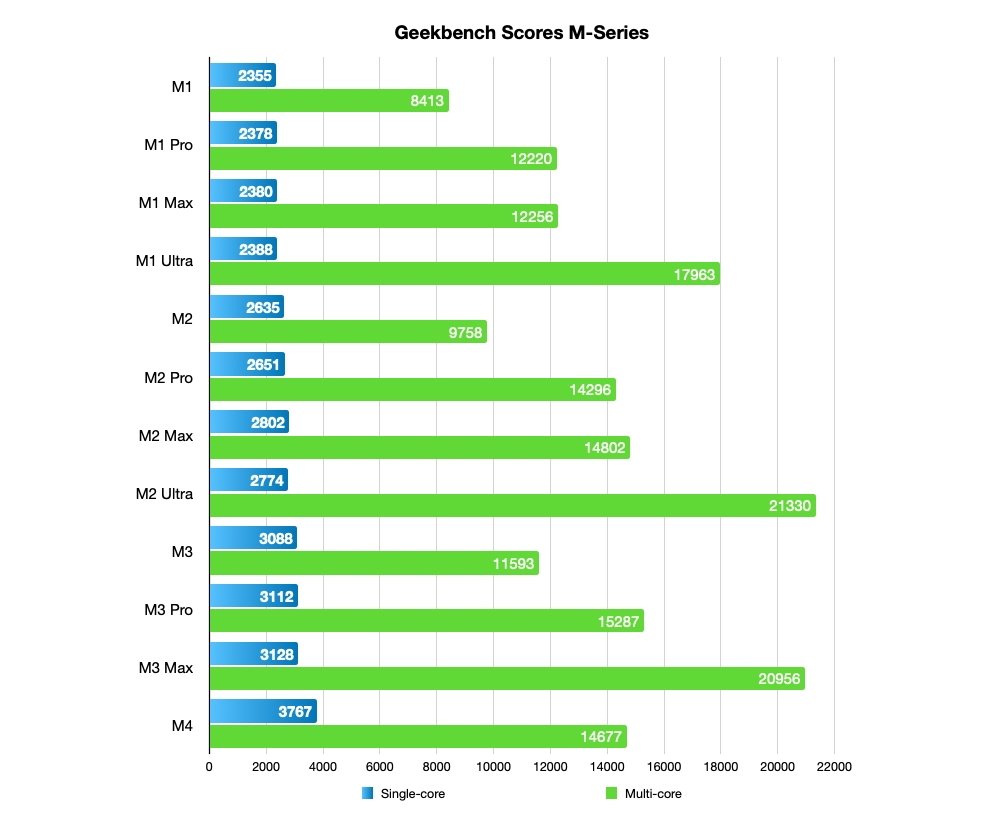
Geekbench scores for M-series chips
The main outlier of the group is the M4, as that's the only one based on iPad Pro benchmarks. This shouldn't matter too much given the performance level it produces, but it doesn't enjoy the benefits of better thermal management systems like its Mac counterparts.
Obviously, the later generation and the higher the chip, the better the performance overall. This is unsurprising, but also not entirely helpful.
Instead, we should look at the base chip of each generation: The M1, M2, M3, and M4.
Pared down to these four, you can certainly see a generational improvement. One that's also growing over time.
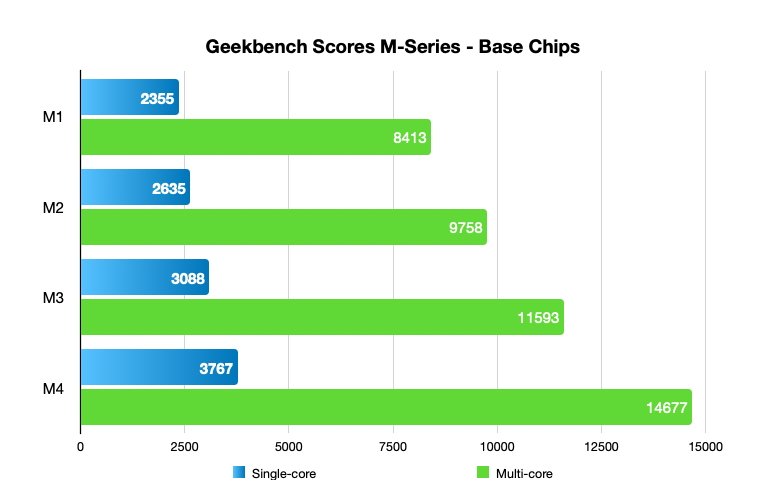
Geekbench scores for the base chips of each M-series generation
The inter-generational improvements start at 12% for single-core and 16% for multi-core from the M1 to M2. By the M3 to M4, they have grown to 22% and 27% respectively.
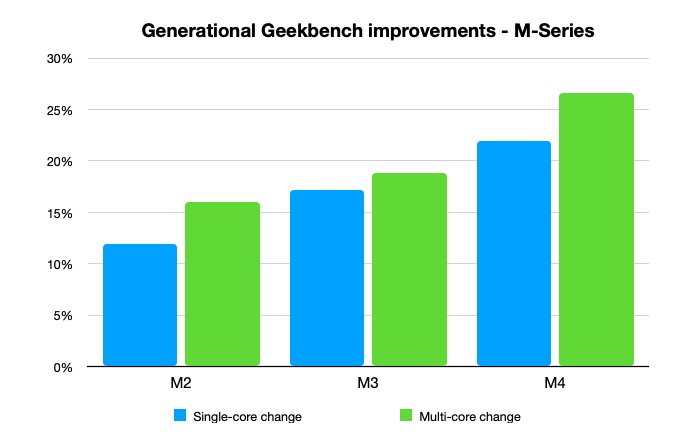
Geekbench generational improvements for core M-series chips
We can't use this technique with the Pro, Max, and Ultra chips due to some hefty variances. For example, the M3 Pro's multi-core score is only 7% better than the M2 Pro, partly due to Apple changing its split of performance and efficiency cores for that release.
M3 Ultra?
While not exactly perfect, we can use these figures and specifications of other released Apple chips to have an educated guess about Apple's unreleased hardware.
The easiest is the M3 Ultra, which stands a chance at being unveiled at WWDC. That is, if Apple is okay with a M3 Ultra being out at the same time as a core M4 chip.
If Apple stays true to form, the M3 Ultra will be double the specification of the M3 Max in every way -- but this is just an educated guess, as there's no traditional interconnect visible in M3, like there was in M1 and M2.
In theory, that would mean a choice of a 28 or 32-core CPU with either 20 or 24 performance cores and eight efficiency cores. There'll also be a 32-core Neural Engine with 36 trillion operations per second, and 800GB/s of memory bandwidth.
As for the M4 Pro, Max, and Ultra, we can look at the M3 variants and increase many of the specifications by a small amount for a ballpark figure.
For example, the M4 Pro could have 11 or 12 CPU cores like the M3 Pro. But since Apple increased the core count for the M4, the Pro could go up to 13 or even 14 cores.
The M4 Max could comfortably equal the 14 or 16 core counts of the M3 Max without issue. Again, M4 Ultra could double whatever the M4 Max uses.
GPU core counts could go up modestly more, such as 16 to 20 for the Pro, and 40 to 50 for the Max.
Apple likes to keep the Neural Engine the same across a generation, so the 16-core 38TOPS of the M4 will spread to the Pro and Max. The Ultra will therefore hit 76TOPS.
If the M4 Pro and Max have the same sort of performance boost over their M3 counterparts as the M4, the figures could be surprising.
In the case of the M3 Max, single-core performance could be 3,800 or thereabouts in Geekbench, based on a 22% improvement. Multi-core for the chip could tip the scales at over 26,000 if the 27% improvement is maintained.
None of this is certain. The rumor mill suggests that a M3 Mac Studio or Mac Pro may not be released. We'll see in the fullness of time.
Extrapolating M4 to iPhone 16 A18
Like the M-series, the A-series has seen gradual growth over the years. Since it's Apple's design teams that are working on both chip lines, it's also easy to expect there to be considerable similarities between the two.
Indeed, Apple's M-series was originally built upon its experiences building up the A-series chips.
While there are a lot of similarities, there are also quite a few differences. These are typically due to the A-series being made for the iPhone and iPad, rather than a Mac.
Since active cooling isn't available on Apple's mobile devices, the company has to design its A-series to run cooler. Since you're not going to be performing much in the way of high-level processing on an iPhone, this is also taken into account.

The iPhone 15 Pro, which contains the A17 Pro
In the A-series since the A13 Bionic, this has meant Apple uses a six-core layout of two performance cores and four efficiency cores. That's two performance cores fewer than most of the core M-series counterparts.
The GPU also gets hit for the same reasons, so there are fewer cores in use. The A13 and A14 have four, the A15 and A16 have five cores, and the A17 Pro has six.
This is also half the core counts of the core M-series chips, if you start the M1 alongside the A14 and work upward. That is, except for the A17 and M4 which have six cores and ten cores respectively.
However, since Apple usually has two GPU core count options and it has only offered one so far for the M4, there could be a second one on the way with its first Mac update using the chip. Following the trend, that should be a 12-core version.
The Neural Engine has 16 cores in the A-series much like the M-series. But again, the performance of the part seemingly mirrors M-chips.
The A14's Neural Engine can do 11 trillion operations per second, like the M1, with the A15's 15.8 trillion doing the same as the M2. The A16 differs slightly with 17 trillion against 18 trillion for the M3.
Like the M4, the A17 Pro saw a big performance jump to 38 trillion operations per second.
Then there's the foundry process, which again starts at 5nm for the A14 and A15, dips to 4nm for the A16, and hits 3nm on the A17 Pro. This, once again, kinda mimics the M-series, except the M3 went straight to 3nm without the 4nm step.
A-series - Performance gains
Performance-wise, the A-series has seen more gradual computing improvements.
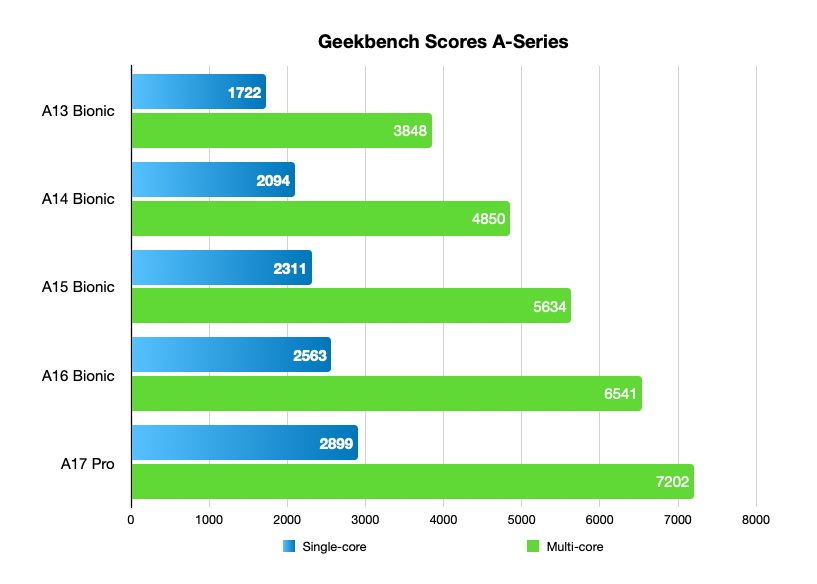
Geekbench scores for A-series chips
Under Geekbench for the Pro Max models of iPhone using each chip, the range starts from the A13 Bionic's 1,722 single-core and 3,848 multi-core scores. The A14 broke 2,000 with its single-core performance, and almost hit 5,000 with multi-core.
This introduced a regular pattern of improvements over time, resulting in the A17 Pro's 2,899 single-core score and 7,202 for multi-core. While single-core performance has grown 68% over four years, multi-core has almost doubled in the same timeframe, at 87%.
Generationally speaking, the A14 Bionic saw a 22% single-core improvement over the A13, with 26% for the multi-core version.
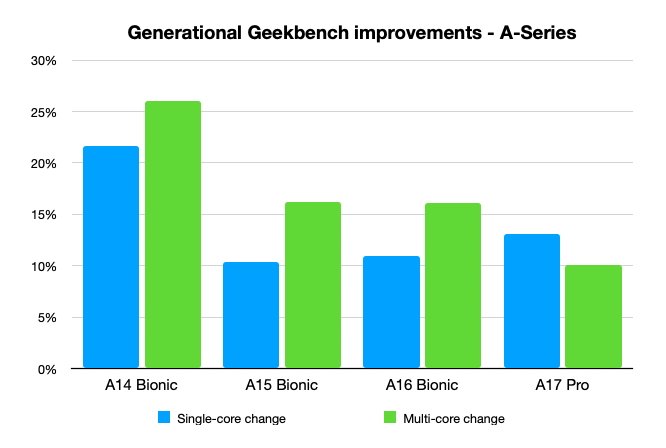
Percentage changes in Geekbench scores for A-series chips
In subsequent years, the increases have been more restrained, being between 10% and 16% each year. For the A17 Pro, the upgrades were 13% and 10% for single-core and multi-core testing respectively.
iPhone 16 A18 performance predictions
Looking at the specifications and figures alone, we could have a good guess as to what the A18 could be like.
For a start, Apple seems to prefer to maintain its six-core arrangement over time, so the two-performance, four-efficiency split could still be maintained.
Thermal limitations mean Apple is unlikely to buck the trend on GPU core counts, so sticking at six like the A17 Pro could be a good estimation.
We could also be reasonably safe in betting the performance gains in something like Geekbench could be at least 10%. That would mean scores in the region of 3,200 for single-core testing, and 7,900 for multi-core.
The real problem area for extrapolation is the significant change in direction for the company to embrace AI. There is a bigger push to make AI more useful to the end-user and for Apple to incorporate it in its products.
Rumors have said that Apple will beef up the AI chops of its chips in preparation. However, Apple already has made some changes in the A17, doubling the operations per second from the A16 to 38 trillion.
If Apple is going to make AI-forward changes, the focus will be on the Neural Engine. That should mean using more effective cores, increasing the core count from the standard 16, or a combination of the two.
Whatever Apple comes up with, Mac users will be keen to watch. However Apple produces the A18 chip, the M5 will surely follow in the same direction.
Read on AppleInsider

Comments
So I don't think we will ever see a M3 Ultra. I think we will see the M4 Pro, M4 Max, and then M4 Ultra.
The release of the M4 says to me that Apple is not in any way constrained by what they've done in the past. Instead, Apple is going to do whatever they think makes the most sense for a given product at a given point in time, given feasibility constraints. So the only way to have a shot at predicting what they're going to do is if you can get inside their head about what makes sense for a given product and if you have some information about feasibility constraints. Those are not easy things to do.
For a while now, my guess has been that Apple would design and use their own server chips in their own data centers, and that they would also sell those chips in high-end Mac desktops. I don't know when that will happen, but it could very well begin at WWDC with an M4 Ultra class chip. But that Ultra might not be two Max chips slapped together. Instead, I wonder if Apple will separate the CPU and GPU cores into two dies that are connected via Ultra Fusion (or its descendent), allowing more mixing and matching of CPU and GPU cores for different use cases, which could be good for them (since they have different use cases in their data centers) and good for pro Mac users. I wonder that not because they've ever done it before, but because I think it might make sense to do it in the future.
I think they will still call the packaging “UltraFusion,” but it will be next-generation or whatever.
I also love how everyone is suddenly an expert on TSMC's operations and what they "want." Apple used N3E for M4 because it was already in production and the timing was right for the iPad Pro and the new display engine. It's got nothing to do with N3B, which is doing just fine, thank you, with Intel also on board, using N3B for Arrow Lake and Lunar Lake, in addition to most of Apple's actual, current flagship products, iPhone Pro and MacBook Pro, not to mention iMac and MacBook Air.
But it's true that Apple will always update as much as possible, and not hold anything back, which is something Intel used to do, and probably still does. Here's Anand Shimpi talking about that (with Andru Edwards): "On the silicon side, the team doesn’t pull any punches, right? ... The goal across all the IPs is, one, make sure you can enable the vision of the product, that there’s a new feature, a new capability that we have to bring to the table in order for the product to have everything that we envisioned, that’s clearly something that you can’t pull back on. And then secondly, it’s do the best you can, right? ... Get as much down in terms of performance and capability as you can in every single generation. The other thing is, Apple’s not a chip company. At the end of the day, we’re a product company. So we want to deliver, whether it’s features, performance, efficiency. If we’re not able to deliver something compelling, we won’t engage, right? ... We won’t build the chip. So each generation we’re motivated as much as possible to deliver the best that we can."
You don't know anything about TSMC's yields. The only rumor about that is more than a year old, and it just said yields were on track at that early stage. It's absurd. That information is a closely-guarded trade secret.